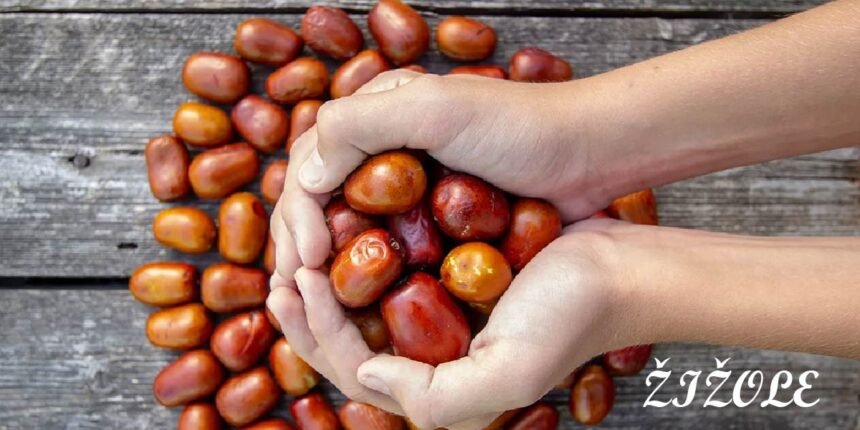What Are Žižole?
Žižole, commonly known as jujube, Chinese date, red date, or unabi, are small, reddish-brown fruits from the Ziziphus jujuba tree. These fruits have been cherished for thousands of years for their medicinal, nutritional, and culinary uses. Often mistaken for dates due to their appearance when dried, žižole have a distinct profile. Fresh žižole are green to reddish and have a crisp texture with a mild sweetness that resembles apples. When dried, they become chewy and dark brown with a flavor closer to figs or dates.
Historically, žižole have been consumed across Asia, the Middle East, and the Mediterranean, both as food and natural medicine. In recent years, ži žole have been rediscovered as a modern superfruit due to their high antioxidant content, digestive support, and adaptogenic properties. The growing global interest in clean eating and holistic wellness has brought ži žole back into the spotlight, making them a staple in modern diets while honoring centuries of traditional use.
Botanical Identity and Origin of Žižole
The botanical name of žižole is Ziziphus jujuba, and it belongs to the Rhamnaceae family. It is a deciduous tree or shrub native to China, where it has been cultivated for more than 4,000 years. Over time, this resilient species spread to Korea, India, and the Middle East, eventually reaching the Mediterranean and parts of Europe, including Croatia, Italy, and Greece. The tree is known for its adaptability—it grows well in warm climates, tolerates drought, and thrives in a variety of soils.
Typically reaching 5 to 10 meters in height, the žižole tree has thorny branches, shiny green leaves, and small yellowish-green flowers that bloom in early summer. The fruits are drupes, olive-sized with thin edible skin, a crunchy interior when unripe, and a chewy center when mature. Ži žole trees are admired not only for their fruit but also for their hardiness and ease of maintenance, making them a valuable agricultural asset in sustainable and water-scarce regions.
Varieties of Žižole and Their Characteristics
There are several varieties of žižole cultivated across the world, each offering unique flavors, textures, and culinary benefits. The ‘Li’ variety is large, round, and very sweet, often eaten fresh for its crisp, apple-like bite. The ‘Lang’ variety is longer and more fibrous, making it ideal for drying. ‘Honey Jar’ is a small, round, and extremely sweet type, perfect for snacking or baking. ‘Shanxi Li’ is another popular variety known for its large size and juicy texture.
Fresh žižole tend to be light green to red, crisp, and slightly tart, while dried ži žole are dark brown and chewy with a rich, sweet taste. The drying process intensifies their natural sugars and concentrates their nutritional content. Depending on the variety, some are better suited for making tea, jams, or wine, while others are perfect for fresh eating or traditional medicine. These diverse varieties make žižole one of the most versatile fruits available today.
A Brief History of Žižole
The history of žižole dates back over four millennia, with deep roots in Chinese civilization. In ancient China, ži žole were praised not only for their pleasant taste but also for their medicinal properties, particularly in Traditional Chinese Medicine (TCM). The fruit was believed to nourish the blood, soothe the mind, and support longevity. From China, ži žole spread to other parts of Asia, including Korea and India, and later to the Middle East and Europe.
In Mediterranean regions such as Dalmatian Croatia, Slovenia, and southern Italy, žižole became part of traditional harvest celebrations. People would dry the fruits for winter use, cook them into syrups, or ferment them into žižolana rakija, a medicinal liqueur. Folklore often associates ži žole with health, prosperity, and good fortune. Today, this cultural reverence continues in regions where žižole are still grown, harvested, and celebrated during seasonal markets and family gatherings.
Nutritional Value of Žižole
Žižole are a powerhouse of nutrition packed into a small fruit. A 100g serving of fresh ži žole typically contains around 79 calories, 20g of carbohydrates, and a good amount of dietary fiber—about 2.6g. They are exceptionally rich in vitamin C, offering over 60–80% of the recommended daily intake, making them excellent for boosting immunity. Potassium levels are also high, supporting heart health and fluid balance.
Other nutrients include iron (important for red blood cell production), calcium (bone health), and B vitamins. Dried ži žole have higher concentrations of sugar and calories but offer enhanced antioxidant levels due to the dehydration process. They contain polyphenols, flavonoids, and saponins—all known for their anti-inflammatory and immune-boosting effects. Compared to dates and goji berries, žižole are lower in sugar and calories while offering more vitamin C, making them ideal for people seeking a healthier sweet alternative.
| Nutrient | Fresh Žižole (100g) |
|---|---|
| Calories | 79 kcal |
| Carbs | 20 g |
| Fiber | 2.6 g |
| Vitamin C | 69 mg |
| Potassium | 250 mg |
| Iron | 0.5 mg |
Health Benefits of Žižole
Žižole offer a wide range of health benefits that make them more than just a tasty snack. Their high vitamin C content plays a key role in boosting the immune system, helping the body fight infections and heal wounds faster. Traditional Chinese Medicine has long used ži žole as a natural remedy for insomnia. Compounds like jujuboside A have mild sedative effects, which help improve sleep quality and reduce anxiety.
These same calming properties contribute to lowering stress levels. The fruit’s dietary fiber content supports digestion, encourages regular bowel movements, and promotes a healthy gut microbiome. Žižole also possess anti-inflammatory and antioxidant effects, thanks to the presence of polyphenols and flavonoids. These compounds protect the body from free radical damage and may reduce the risk of chronic diseases. Moreover, ži žole can promote clearer skin, enhance energy levels, and help with weight management due to their low calorie and sugar profile when eaten fresh.
Žižole in Traditional Medicine Systems
Žižole have held a prominent place in traditional medicine for centuries. In Traditional Chinese Medicine, they are seen as a tonic fruit that harmonizes the body’s energy (qi), strengthens the spleen and stomach, and calms the mind. Herbalists frequently include dried ži žole in teas, soups, and medicinal decoctions to treat insomnia, fatigue, and digestive issues. In Ayurveda, the fruit is considered a rejuvenative (rasayana) known to restore vitality, balance the doshas, and support the nervous system.
European folk traditions, particularly in the Balkans and Italy, also value žižole. They are commonly turned into syrups to soothe sore throats or brewed into infusions for stress and stomach ailments. These traditional uses are now supported by modern research confirming the fruit’s adaptogenic, antioxidant, and anti-inflammatory properties. The widespread use of ži žole across different healing systems underlines its value as a truly global medicinal fruit.
Culinary Uses of Žižole
Žižole is a culinary delight thanks to its ability to be used fresh, dried, or cooked. When fresh, they are crisp and refreshing, often eaten as-is or chopped into salads. Their apple-like crunch and light sweetness pair well with soft cheeses, yogurt, or nuts. Dried ži žole have a richer, deeper flavor and chewy texture, perfect for trail mixes, baked goods like muffins and breads, or added to cereals and granola. In traditional cooking, they are boiled to make jams, jellies, and chutneys.
One of the most popular uses is žižole tea, made by simmering the dried fruit with ginger and cinnamon. This calming drink is widely used in Asian cultures for improving sleep and digestion. In Croatia and other Balkan countries, the fruits are soaked in brandy to create a medicinal liqueur known as žižolana rakija. Powdered or fermented forms of ži žole are now emerging in wellness recipes, smoothies, and health supplements.
Žižole vs. Dates and Other Superfruits
When compared to other popular superfruits like dates, goji berries, and acai, ži žole stand out for their unique nutritional and culinary balance. Dates are rich in sugar and calories, offering quick energy but lacking vitamin C. Goji berries provide antioxidants but have a stronger, sometimes bitter taste. Acai berries are high in antioxidants but usually come in frozen or powdered form. Žižole, on the other hand, are versatile and can be eaten fresh, dried, or cooked.
They have moderate sugar levels, high vitamin C, and a pleasing flavor that works in both sweet and savory dishes. Their low glycemic index and adaptogenic effects make them suitable for diabetics and those with stress-related conditions. Overall, žižole offers a broader range of health benefits with fewer calories, making them a more balanced and accessible superfruit.
| Fruit | Texture | Sugar Content | Vitamin C | Best Use |
|---|---|---|---|---|
| Žižole | Crisp/Chewy | Moderate | High | Fresh, tea, jam |
| Dates | Sticky | Very High | Low | Desserts, energy |
| Goji Berries | Chewy | Low | Moderate | Smoothies |
| Acai | Pulp | Low | Moderate | Juices, powders |
How to Incorporate Žižole Into Your Diet
Adding žižole to your diet is simple and enjoyable. Dried žižole make an excellent snack on their own or combined with nuts and seeds in a trail mix. Fresh ži žole can be sliced into salads, blended into smoothies, or eaten like apples. They bring natural sweetness and crunch without added sugars. For breakfast, try mixing dried ži žole into oatmeal or yogurt bowls. In baking, they work well as a substitute for dates or raisins in cookies, muffins, and cakes.
If you’re into traditional remedies, boil dried ži žole with ginger and honey to make a calming tea. Adventurous cooks can make jams, chutneys, or even infuse ži žole into spirits for a homemade liqueur. With their pleasant taste and wide range of applications, ži žole can be easily incorporated into any lifestyle or cuisine.
Growing and Harvesting Žižole Trees
Growing your own žižole tree is both practical and rewarding. The trees thrive in USDA zones 6–10 and prefer full sun and well-drained soil. They are drought-tolerant once established and can handle various soil conditions. Planting should be done in early spring, spacing trees 10–15 feet apart. Regular pruning helps maintain shape and boosts fruit production. Ži žole trees start bearing fruit within 3–5 years, and harvesting typically occurs from late summer to early autumn when the fruits turn from green to reddish-brown and begin to wrinkle.
Gently twist the fruits from the branches or collect them once they fall. Fresh žižole should be stored in a cool, dry place, while dried ones can last for months when kept in an airtight container. Their low maintenance needs and high yield make ži žole trees a favorite among home gardeners and sustainable farmers.
Where to Buy Žižole
Žižole can be found fresh during the late summer and early fall at local farmers’ markets, especially in Mediterranean countries. Dried ži žole are more widely available year-round in Asian supermarkets, health food stores, and organic markets. Online herbal retailers and natural food websites often stock them in various forms—whole dried fruits, teas, powders, or syrups.
Specialty stores catering to Eastern European or Chinese clientele are also good sources for traditional ži žole products like jam or rakija. When shopping, look for sun-dried, organic, or pesticide-free options for the best nutritional value. Their growing popularity means more availability worldwide, especially in wellness circles and functional food markets.
Žižole in Modern Wellness Trends
In the current health-conscious era, žižole are experiencing a major resurgence. They are now recognized as adaptogens—natural substances that help the body adapt to stress and restore balance. This has made them popular ingredients in nootropic supplements and calming teas. Wellness influencers highlight ži žole for its anti-anxiety, sleep-enhancing, and skin-nourishing properties. Clean-eating advocates and herbalists often recommend ži žole as part of a plant-based, immune-boosting diet.
Their versatility, sustainability, and cultural roots position them perfectly in today’s functional food market. As more consumers seek alternatives to processed snacks and synthetic supplements, žižole offers a pure, time-tested option.
Environmental and Agricultural Value
Žižole trees are not only useful for health and nutrition but also contribute to sustainable agriculture. Their ability to thrive in dry, nutrient-poor soils makes them ideal for areas affected by water scarcity. They require minimal pesticides and fertilizers, making them an eco-friendly crop.
The tree’s resilience against pests and diseases further reduces the need for chemical intervention. By promoting ži žole cultivation, communities in the Mediterranean and beyond can encourage biodiversity, support local economies, and preserve traditional farming practices. Žižole represents an excellent example of a low-input, high-yield crop with strong cultural, nutritional, and ecological benefits.
Cultural Significance and Festivals
Žižole have strong cultural associations in the regions where they are traditionally grown. In China, they are symbols of fertility, longevity, and prosperity, often given as wedding gifts or included in festival dishes. In Croatia, Slovenia, and Italy, žižole feature prominently in autumn harvest festivals.
Families come together to pick the fruits, dry them, or make them into syrup, jam, or brandy. These traditions preserve ancestral knowledge and connect generations through seasonal rituals. Recipes passed down from grandmothers to grandchildren ensure that ži žole remains a living part of culinary and healing heritage. Such events also support agritourism and help promote local biodiversity.
Conclusion
Žižole is more than just another fruit—they are a symbol of ancient wisdom, nutritional excellence, and culinary delight. Their impressive health benefits, adaptability in recipes, and historical significance make them a true superfruit. Whether you’re looking to boost your immunity, improve your sleep, or reconnect with traditional healing foods, ži žole offers a unique solution. They are easy to grow, easy to eat, and easy to love. In a world full of processed foods and artificial supplements, ži žole stands out as a wholesome, sustainable, and powerful choice for better living. Add them to your routine today and experience the ancient sweetness of wellness reborn.
FAQs About Žižole
What is Žižole?
Žižole is another name for jujube, also known as Chinese date. It is a small, round fruit that is green when unripe and turns reddish-brown as it ripens. Ži žole can be eaten fresh or dried and is known for its sweet taste and many health benefits.
What are the health benefits of Žižole?
Žižole is rich in vitamin C, antioxidants, and fiber. It helps boost the immune system, improve digestion, support better sleep, reduce stress, and promote healthy skin.
How do you eat Žižole?
You can eat Žižole fresh like an apple, or dried like a date. It can also be added to tea, baked goods, jams, or salads. Dried Žižole is often used in traditional medicine and herbal remedies.
Where can I buy Žižole?
Žižole can be found at farmers’ markets (fresh), Asian grocery stores (dried), health food stores, or online herbal shops. Look for organic or sun-dried options for the best quality.
Can I grow a Žižole tree at home?
Yes, Ži žole trees are easy to grow. They need full sunlight and well-drained soil. They are drought-resistant and can grow well in warm or Mediterranean climates. The fruit is usually harvested in late summer or early fall.
For More Information Visit Fourmagazine







